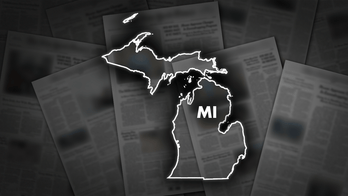President Obama ordered the federal government on Thursday to cut its emissions of greenhouse gases by 40 percent, as the U.S. seeks to spur other nations to get serious about climate change.
Obama's executive order also directs the government to ramp up use of renewable energy sources to 30 percent of the federal government's consumption. The White House said U.S. taxpayers could save up to $18 billion in electricity costs by reducing greenhouse gases 40 percent over the next decade, compared to 2008 levels.
"These are ambitious goals, but we know they're achievable goals," Obama said on the roof of the Energy Department, where he toured a solar panel installation after signing the executive order at the White House.
Major companies that sell to the federal government like GE, HP, Northrup Grumman and Honeywell will also announce voluntary commitments to cut their own emissions of the heat-trapping gases blamed for global warming, the White House said. IBM, for example, said it will cut its energy consumption 35 percent by 2020 and buy at least 20 percent of its power from renewably sources by that year.
All told, the government pollution cuts along with industry contributions will have the effect of keeping 26 million metric tons of greenhouse gases out of the air by 2025, or the equivalent of what about 5.5 million cars would pump out through their tailpipes in an average year, the White House said. Yet it was unclear exactly how either the government or private companies planned to meet those targets.
While at the Energy Department, Obama also planned to discuss the new emissions targets at a roundtable with federal suppliers that do more than $1 billion per year in business with the government.
The U.S. government is responsible for only a small portion of the world's greenhouse gas emissions, but the Obama administration is hoping that taking aggressive steps at home will increase the political pressure on other countries to do the same.
"Certainly our hope is that we are laying forth template that other countries could also learn from and look at as well," said Brian Deese, a senior adviser to Obama.
A major global climate treaty, in the works for years, is supposed to be finalized in December at a summit in Paris, but most countries have yet to announce what their national contributions to the pact will be. Earlier this month the European Union unveiled its contribution, vowing to cut greenhouse gas emissions at least 40 percent by 2030, compared to 1990.
The U.S. has yet to announce its contribution to the treaty. But in a bid to build momentum last year, Obama set a U.S. goal to cut emissions up to 28 percent by 2025 -- compared to 2005 levels -- in a joint announcement with China that boosted hopes that an aggressive climate treaty may come to fruition.
The president hasn't fully explained how he'll meet that goal, but his aides have suggested that unprecedented pollution limits he's imposing on power plants will get the U.S. much of the way there.
Obama's executive order will direct the federal government to:
-- Cut energy use in federal buildings 2.5 percent every year between 2015 and 2025.
-- Reduce the amount of water used in federal buildings 2 percent every year through 2025.
-- Decrease greenhouse gas emissions from federal vehicles by 30 percent per mile by 2025, compared to the levels in 2014.
-- Ensure federal agencies are getting 25 percent of their energy -- both heat and electricity -- from clean sources by 2025.
-- Put more hybrid and zero-emission vehicles in the federal fleet of cars and trucks.




